How SaaS Management Improves IT Governance
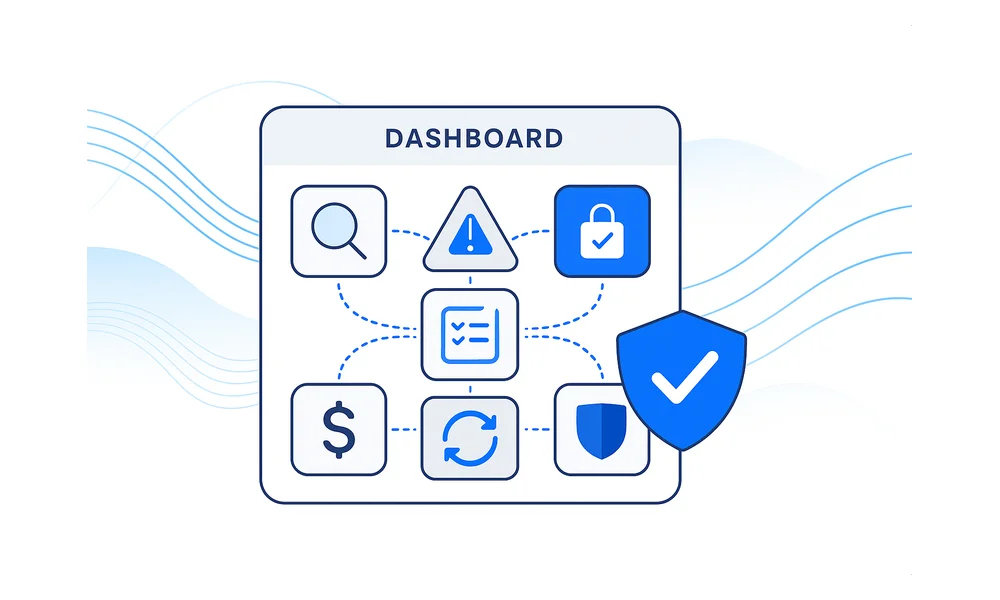
Week after week, another team signs up for yet another cloud app and leaves upkeep to IT. Licenses stack up, data drifts across regions, auditors ring, and the dashboard stays empty.
A SaaS Management Platform closes that gap. From a single console you can identify every app, enforce access rules, assess vendor risk, collect audit trails, eliminate wasted spend, map licenses to headcount, and run joiner-mover-leaver workflows on autopilot. When finance, security, and operations work from the same inventory, governance keeps pace with cloud speed.
The following pages unpack each function so you can decide whether one platform outperforms the patchwork you’re juggling today.
Table of Contents
- Total SaaS visibility, no surprises
- One console to lock down access
- Stay ahead of vendor risk shifts
- Audit reports done before auditors ask
- Spend smart by right-sizing every license
- Seamless joiners, swift exits, data safe
- Conclusion
- Audit your company's SaaS usage today
Total SaaS visibility, no surprises
Complete SaaS visibility starts with discovery.
A SaaS Management Platform scans every corner of the tech stack to surface both approved and shadow apps, giving IT a single, always-on source of truth.
Data feeds pour in from several angles:
- OAuth grants pulled from Google Workspace or Microsoft 365
- SSO event logs from Okta, JumpCloud, or Azure AD
- Network traffic from secure web gateways that spot new domains
- Card or ERP spend lines that reveal fresh subscriptions
Each feed lands in the same dashboard within hours, so a surprise Canva trial or rogue AI chatbot appears before it turns into risk. BetterCloud’s 2023 report counts 371 SaaS apps at the average mid-market firm; without this cross-check many stay hidden.
Tags and filters sharpen the picture. Security teams split apps by PII scope, finance tags them by cost center, and regional leads slice by data residency. When the board asks how many customer-data systems run in APAC, the answer sits two clicks away, complete with real-time user counts.
Continuous updates matter as much as the first scan. New hires join Slack, a contractor leaves GitHub, or a department spins up Figma; the platform refreshes snapshots every few hours, so policy engines and cost models never run on stale data. If an OAuth scope moves from “read” to “write,” an alert fires and the CISO can lock it down immediately.
Discovery lays the groundwork for every other control. Role-based access, vendor risk scoring, audit evidence, and spend optimization all depend on knowing what exists. Miss one app today and tomorrow’s offboarding script fails, an auditor flags a gap, or Legal spots an unsanctioned data flow.
By turning fragmented signals into a living inventory, a SaaS Management Platform flips the visibility problem from a constant chase to continuous insight, letting IT steer growth without losing track of what’s already running.

One console to lock down access
Centralized control slashes risk. A single dashboard keeps it that way.
SaaS management platforms connect to identity providers, HR systems, and each SaaS admin API. They then push one set of rules out to every tool. End users see only a quick login and the exact resources they’re permitted. Under the hood, the platform scores every session against policy. Finance intern trying to grab source code in GitHub? Blocked. A sales rep inactive for 30 days loses the token before quarter-close.
Policy templates speed the job. Admins pick the guardrail, edit a few fields, and hit publish. The platform does the rest.
- Least-privilege: map HR titles to app roles and strip admin rights from any mismatch
- MFA everywhere: turn on SAML or OIDC, then flag apps still taking a password
- Conditional blocks: deny logins from sanctioned regions or outside work hours
- Dormant cleanup: auto-revoke seats after a set idle window and send alerts to Slack
Time metrics prove value fast. A 2023 BetterCloud study showed median time-to-close an access violation fell from 48 hours to 11 minutes once customers pushed policies from one console. The same data set logged a 62 percent jump in the number of apps with SAML enabled during the first month of rollout.
Real-world urgency sits behind those numbers. When GitHub reported suspicious OAuth activity tied to Heroku and Travis CI in April 2022, the security team revoked every affected token within hours. Companies running a SaaS management layer were already covered; dormant-token rules had wiped unused keys, shrinking exposure before GitHub’s alert reached inboxes.
Data residency rules fold in the same way. A checkbox shields EU-hosted HR data from U.S. Contractors, and a DLP scan stops a spreadsheet with Social Security numbers from landing in Dropbox. Nothing new to learn per app, no extra browser tabs, just one place to see the hit count and one place to change the rule.
Governance becomes repeatable rather than heroic.

Stay ahead of vendor risk shifts
Vendor risk changes every week. Spreadsheets can’t keep pace. A SaaS management platform keeps one profile per supplier and feeds it with live signals.
The profile starts with the basics: CAIQ answers, SOC 2 report, penetration-test summary, Dun & Bradstreet score. The tool tags every file with the control it supports, so gaps jump out at first glance. When a vendor tweaks a term or adds a subprocessor, the record refreshes within hours because the platform watches security pages, status feeds, and trust centers.
Governance teams no longer chase email threads. A rules engine decides whether the change matters:
- SLA breach longer than four hours opens a Jira ticket for the service owner
- Drop in BitSight rating below 750 pings the risk channel in Slack
- New data center outside approved regions pauses all new purchases until legal signs off
Each alert shows impact and next steps. The legal group sees contract clauses, security sees the last pen test, and finance sees the spend trend coming from ERP. Everyone comments inside the platform, and the decision lands in ServiceNow the moment they hit approve or deny.
Red flags no longer pile up. The dashboard ranks open issues by blast radius and vendor criticality. During pilot programs, higher-risk apps get a seven-day review cycle; low-risk tools roll forward with auto-renew rules. GitLab cut third-party review time 42 percent after hooking its questionnaire bot to the platform.
Continuous monitoring also guards against quiet drift. If Okta detects a new privileged OAuth scope requested by a vendor, the platform notes the scope, maps it to data access, and rechecks the residual risk score. A change from medium to high triggers fresh sign-off, not an annual review that comes too late.

Audit reports done before auditors ask
Evidence only matters when it maps to a control. A SaaS Management Platform pulls user logs, change histories, and policy attestations as they happen, then tags each record to the right clause in ISO 27001 Annex A, SOC 2 CC, or NIST CSF. The work once spread across spreadsheets, shared drives, and late-night Slack threads now lives in one timeline the audit team can search in seconds.
Export packages sit beside every control. With one click, the platform bundles:
- Timestamped log files in their native format
- Screenshots that prove settings were on when the test ran
- Approval records with name, role, and date
- A checksum so the auditor knows nothing changed in transit
Retention rules keep those files for as long as the framework requires. Seven years for one regulator, 24 months for another? Set the timer and move on. Role-based views hold back HR data from external auditors while still proving the control is met, so privacy and evidence stay balanced.
Numbers back up the time savings. Deloitte’s 2023 compliance pulse report puts manual evidence collection at 40 percent of total audit prep. Automated feeds shrink that slice dramatically, streaming daily artifacts straight to the auditor’s portal and reducing follow-up requests to almost zero.
Faster audits ripple outward. Security engineers spend less time chasing screenshots and more time fixing findings. Finance closes the books sooner because deferred revenue tied to SOC 2 sign-offs hits the ledger on schedule. Board reports move from draft to final without the scramble.
Governance never stays still. New frameworks appear, clauses shift, auditors raise the bar. By anchoring each control to live SaaS data rather than once-a-year uploads, the platform keeps every future audit on the same rail, no matter how often the rulebook changes.
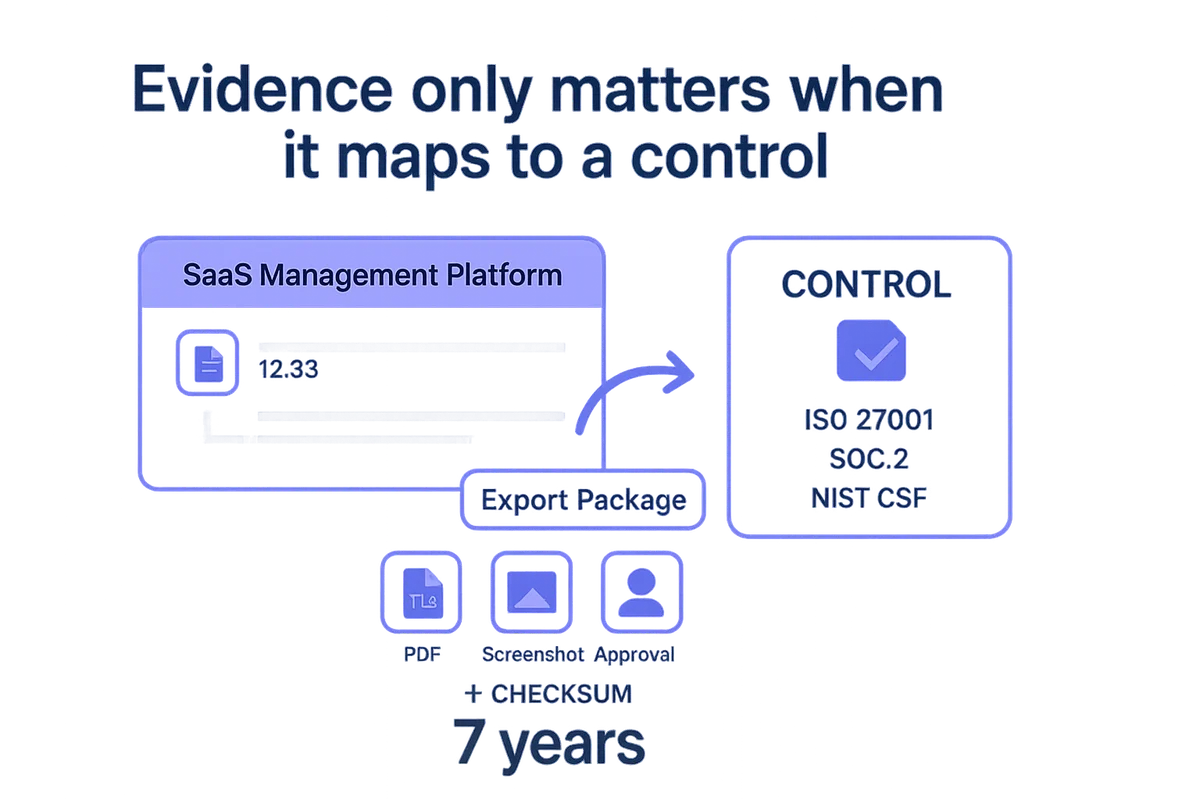
Spend smart by right-sizing every license
Unused SaaS seats drain budgets. A management platform spots that waste before the invoice lands. By pulling contract terms from the procurement system, matching them to real-time usage data, and tagging each record with renewal dates, the tool shows finance and IT where money slips out the door.
A single screen stacks the facts: paid seats, active seats, cost per seat, renewal clock. If Marketing bought 300 licenses for a design app but only 180 people logged in last month, the delta turns red. The platform then builds an action card for the owner. Trim 120 seats now or risk another year of overage. With one click, the request hits Slack, and the license cut flows through the vendor API before lunch.
- Contract reconciliation matches purchase orders with usage every night
- Predictive spend charts project the next 12 months based on current trends and headcount plans
- Renewal alerts fire at 90, 60, and 30 days with suggested negotiation targets
- Policy rules down-provision any seat idle for 30 days unless an app owner opts out
- Duplicate app detection flags overlapping tools in categories like video conferencing or project tracking
Finance teams gain a rolling view of committed versus variable spend, not a rear-view snapshot. That insight feeds budget meetings with hard numbers: which apps must stay, which can shift to annual billing, and which should be folded into an enterprise bundle.
Delivery Hero followed this playbook across 500 SaaS vendors. Automated seat reclamation alone cut its annual subscription bill by 18 percent, freeing millions for product investment. The same dashboards now push quarterly scorecards to the CFO, proving that savings stay locked in rather than drifting back as shadow renewals.
Cost governance is no longer an end-of-year scramble. Continuous license checks, clear renewal timelines, and predictive analytics turn SaaS spend into a controlled line item instead of an unpredictable tax on growth.
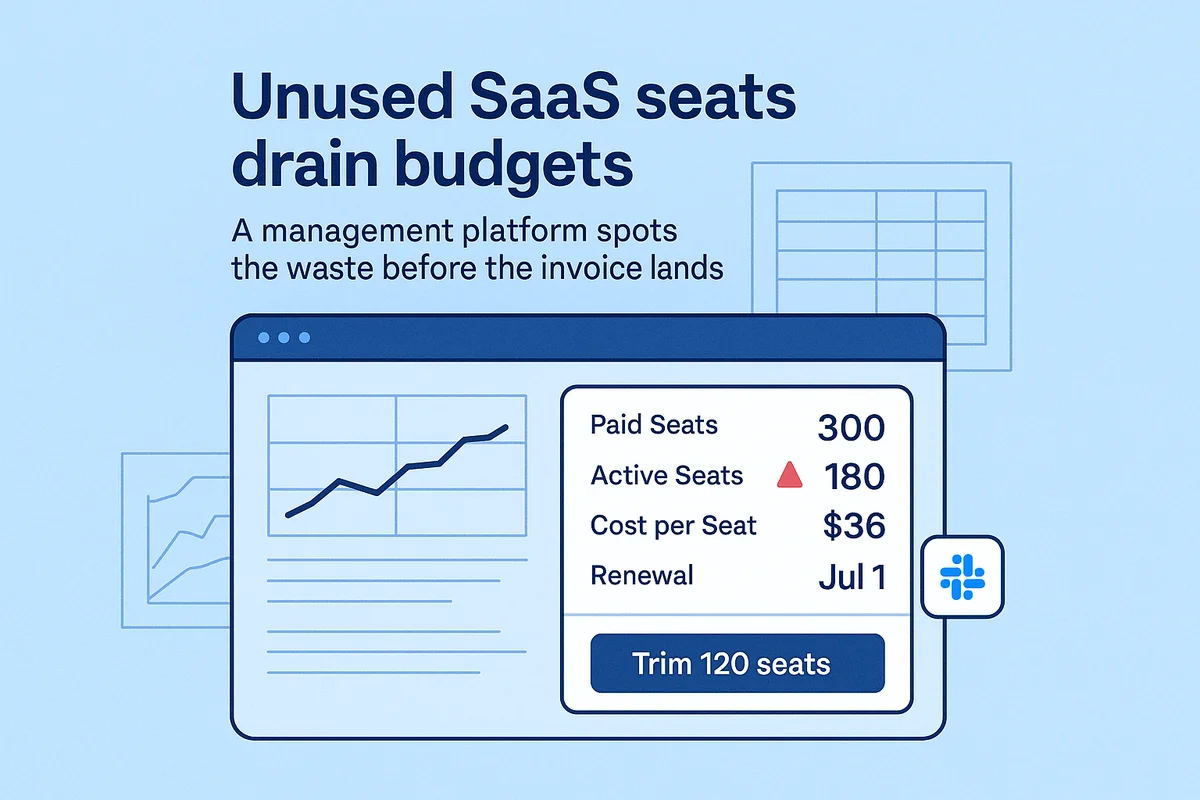
Seamless joiners, swift exits, data safe
Onboarding and offboarding shape SaaS risk.
A SaaS management platform connects to the HRIS, reads start or end dates, and fires off an automated playbook. Once a new hire clears the background check, the platform assigns the right roles in Google Workspace, Jira, Asana, and Slack within minutes. The same trigger also starts a license-expiration timer so a six-month contractor never ends up with a year-long seat.
Departures get even tighter controls. As soon as HR marks an exit, the workflow ends SSO sessions, pulls API tokens, and shifts any owned data to the manager’s folder. Each action is written to an immutable log that satisfies GDPR Article 30 and the CCPA 45-day deletion window.
Data residency holds because the platform ties geofencing rules to every step. A UK engineer who moves to a US office keeps Jira access, but their tickets stay on EU nodes. If a script tries to post those tickets in a US Slack channel, the platform blocks it and pings the DPO.
- HRIS event received
- Role and license map checked
- Access granted or removed across all linked apps
- Data move validated against residency matrix
- Log entry written and signed
The numbers tell the story. Atlassian found that orphaned cloud accounts create up to 80 percent of breach entry points during M&A. Skai cut that exposure to almost zero after deploying an automated SaaS management workflow. One HR trigger closed 620 SaaS accounts across 75 tools in six minutes and logged every line for the auditors. That same month, new hires reached full productivity on day one because the workflow issued 3,400 licenses with no help-desk tickets.
Tuning the flow is straightforward. Drag in a step, pick the app, choose grant or revoke, set the geography rule, and save. Governance tightens up, and nobody queues up for IT.
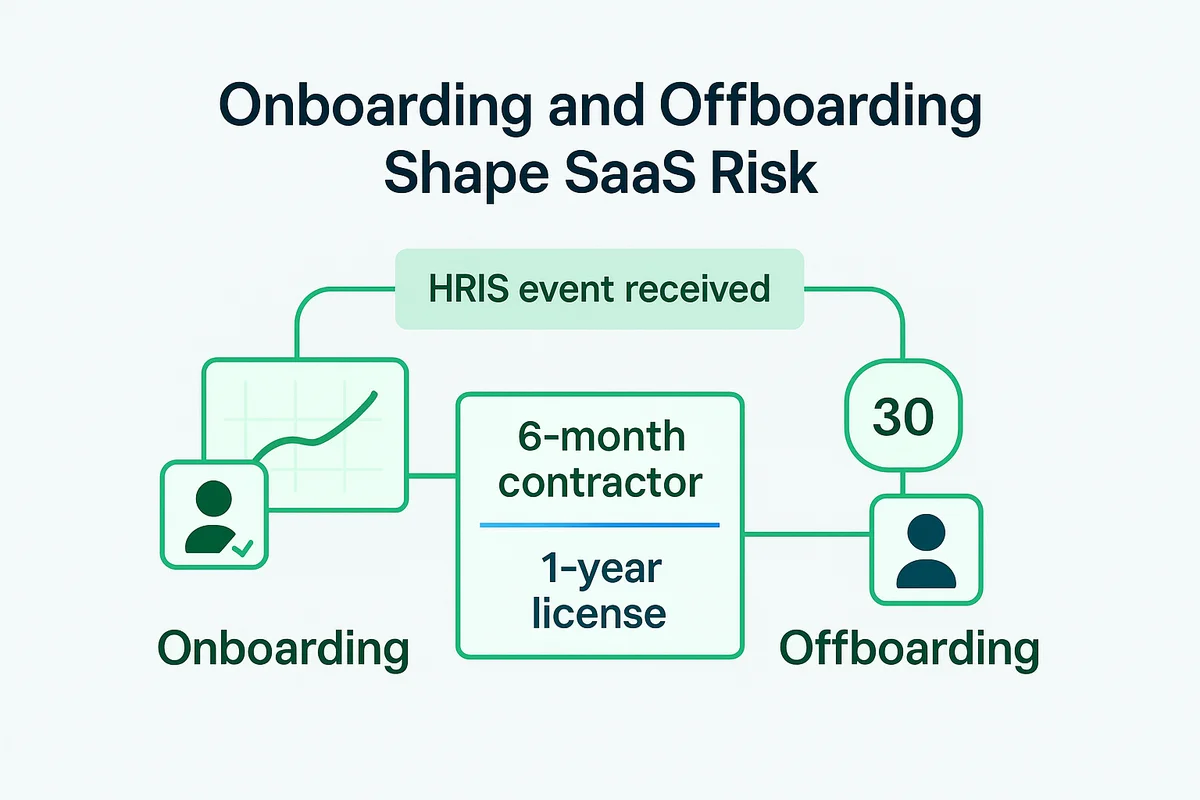
Conclusion
SaaS management platforms combine oversight into a single console. They track every app as seems, apply role settings centrally, monitor vendor uptime, bundle audit evidence, reclaim unused licenses, and close accounts when employees depart. Teams surface shadow IT early, secure data flows, and give finance, security, and the board clear metrics without digging through spreadsheets. Governance scales with each new subscription rather than spawning yet another checklist.
One dashboard keeps IT informed, compliant, and on budget across every cloud tool.
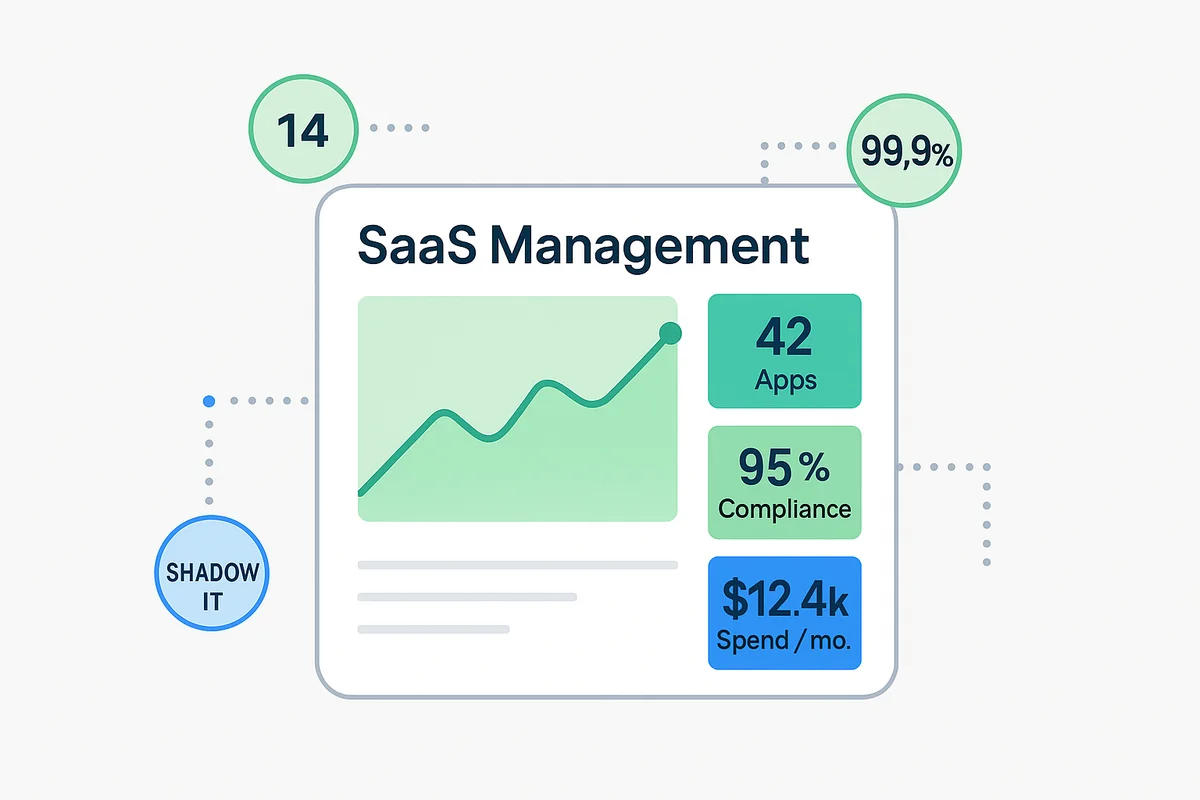
Audit your company’s SaaS usage today
If you’re interested in learning more about SaaS Management, let us know. Torii’s SaaS Management Platform can help you:
- Find hidden apps: Use AI to scan your entire company for unauthorized apps. Happens in real-time and is constantly running in the background.
- Cut costs: Save money by removing unused licenses and duplicate tools.
- Implement IT automation: Automate your IT tasks to save time and reduce errors - like offboarding and onboarding automation.
- Get contract renewal alerts: Ensure you don’t miss important contract renewals.
Torii is the industry’s first all-in-one SaaS Management Platform, providing a single source of truth across Finance, IT, and Security.
You can learn more about Torii here.
Frequently Asked Questions
A SaaS Management Platform offers total visibility of SaaS applications, enables centralized control, manages vendor risk, automates audits, optimizes spending, and enhances user onboarding/offboarding processes.
SaaS visibility allows IT to discover both approved and shadow apps, ensuring no unauthorized software operates unnoticed, thus reducing risks and enhancing compliance.
Centralized control streamlines access management by applying consistent policies across all applications, reducing risks associated with unauthorized access, and enhancing governance.
Vendor risk management continuously monitors supplier profiles and alerts teams of any significant changes or issues, improving decision-making and compliance processes.
Yes, it automates evidence collection, organizes documentation, and streamlines the audit process, significantly reducing preparation time and improving compliance readiness.
The platform identifies unused licenses, reconciles contracts, and sends alerts for renewals, enabling organizations to optimize spending and avoid unnecessary costs.
Automated onboarding/offboarding ensures that user access is granted or revoked based on HRIS updates, streamlining processes and minimizing security risks.

